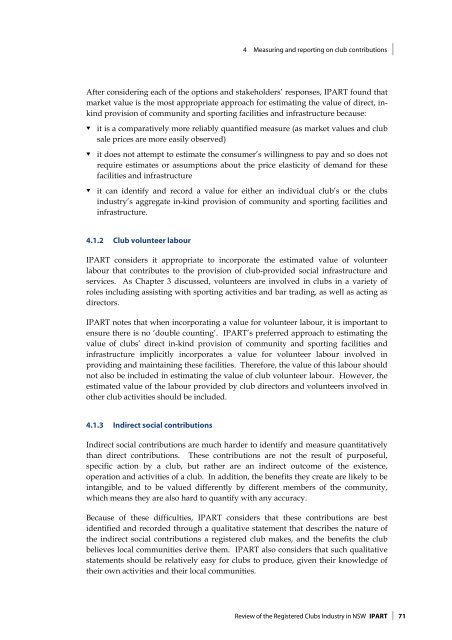Review of the Registered Clubs Industry in NSW - Clubs NSW
Review of the Registered Clubs Industry in NSW - Clubs NSW
Review of the Registered Clubs Industry in NSW - Clubs NSW
You also want an ePaper? Increase the reach of your titles
YUMPU automatically turns print PDFs into web optimized ePapers that Google loves.
4 Measur<strong>in</strong>g and report<strong>in</strong>g on club contributions<br />
After consider<strong>in</strong>g each <strong>of</strong> <strong>the</strong> options and stakeholders’ responses, IPART found that<br />
market value is <strong>the</strong> most appropriate approach for estimat<strong>in</strong>g <strong>the</strong> value <strong>of</strong> direct, <strong>in</strong>k<strong>in</strong>d<br />
provision <strong>of</strong> community and sport<strong>in</strong>g facilities and <strong>in</strong>frastructure because:<br />
<br />
<br />
<br />
it is a comparatively more reliably quantified measure (as market values and club<br />
sale prices are more easily observed)<br />
it does not attempt to estimate <strong>the</strong> consumer’s will<strong>in</strong>gness to pay and so does not<br />
require estimates or assumptions about <strong>the</strong> price elasticity <strong>of</strong> demand for <strong>the</strong>se<br />
facilities and <strong>in</strong>frastructure<br />
it can identify and record a value for ei<strong>the</strong>r an <strong>in</strong>dividual club’s or <strong>the</strong> clubs<br />
<strong>in</strong>dustry’s aggregate <strong>in</strong>-k<strong>in</strong>d provision <strong>of</strong> community and sport<strong>in</strong>g facilities and<br />
<strong>in</strong>frastructure.<br />
4.1.2 Club volunteer labour<br />
IPART considers it appropriate to <strong>in</strong>corporate <strong>the</strong> estimated value <strong>of</strong> volunteer<br />
labour that contributes to <strong>the</strong> provision <strong>of</strong> club-provided social <strong>in</strong>frastructure and<br />
services. As Chapter 3 discussed, volunteers are <strong>in</strong>volved <strong>in</strong> clubs <strong>in</strong> a variety <strong>of</strong><br />
roles <strong>in</strong>clud<strong>in</strong>g assist<strong>in</strong>g with sport<strong>in</strong>g activities and bar trad<strong>in</strong>g, as well as act<strong>in</strong>g as<br />
directors.<br />
IPART notes that when <strong>in</strong>corporat<strong>in</strong>g a value for volunteer labour, it is important to<br />
ensure <strong>the</strong>re is no ‘double count<strong>in</strong>g’. IPART’s preferred approach to estimat<strong>in</strong>g <strong>the</strong><br />
value <strong>of</strong> clubs’ direct <strong>in</strong>-k<strong>in</strong>d provision <strong>of</strong> community and sport<strong>in</strong>g facilities and<br />
<strong>in</strong>frastructure implicitly <strong>in</strong>corporates a value for volunteer labour <strong>in</strong>volved <strong>in</strong><br />
provid<strong>in</strong>g and ma<strong>in</strong>ta<strong>in</strong><strong>in</strong>g <strong>the</strong>se facilities. Therefore, <strong>the</strong> value <strong>of</strong> this labour should<br />
not also be <strong>in</strong>cluded <strong>in</strong> estimat<strong>in</strong>g <strong>the</strong> value <strong>of</strong> club volunteer labour. However, <strong>the</strong><br />
estimated value <strong>of</strong> <strong>the</strong> labour provided by club directors and volunteers <strong>in</strong>volved <strong>in</strong><br />
o<strong>the</strong>r club activities should be <strong>in</strong>cluded.<br />
4.1.3 Indirect social contributions<br />
Indirect social contributions are much harder to identify and measure quantitatively<br />
than direct contributions. These contributions are not <strong>the</strong> result <strong>of</strong> purposeful,<br />
specific action by a club, but ra<strong>the</strong>r are an <strong>in</strong>direct outcome <strong>of</strong> <strong>the</strong> existence,<br />
operation and activities <strong>of</strong> a club. In addition, <strong>the</strong> benefits <strong>the</strong>y create are likely to be<br />
<strong>in</strong>tangible, and to be valued differently by different members <strong>of</strong> <strong>the</strong> community,<br />
which means <strong>the</strong>y are also hard to quantify with any accuracy.<br />
Because <strong>of</strong> <strong>the</strong>se difficulties, IPART considers that <strong>the</strong>se contributions are best<br />
identified and recorded through a qualitative statement that describes <strong>the</strong> nature <strong>of</strong><br />
<strong>the</strong> <strong>in</strong>direct social contributions a registered club makes, and <strong>the</strong> benefits <strong>the</strong> club<br />
believes local communities derive <strong>the</strong>m. IPART also considers that such qualitative<br />
statements should be relatively easy for clubs to produce, given <strong>the</strong>ir knowledge <strong>of</strong><br />
<strong>the</strong>ir own activities and <strong>the</strong>ir local communities.<br />
<strong>Review</strong> <strong>of</strong> <strong>the</strong> <strong>Registered</strong> <strong>Clubs</strong> <strong>Industry</strong> <strong>in</strong> <strong>NSW</strong> IPART 71
















